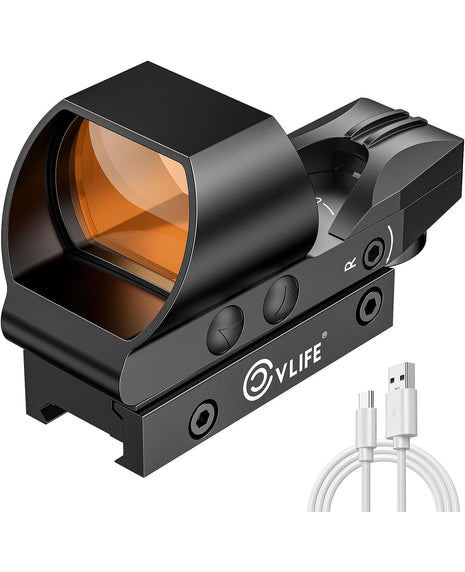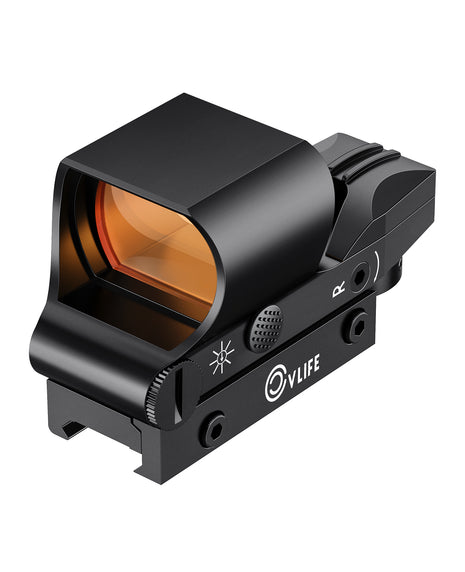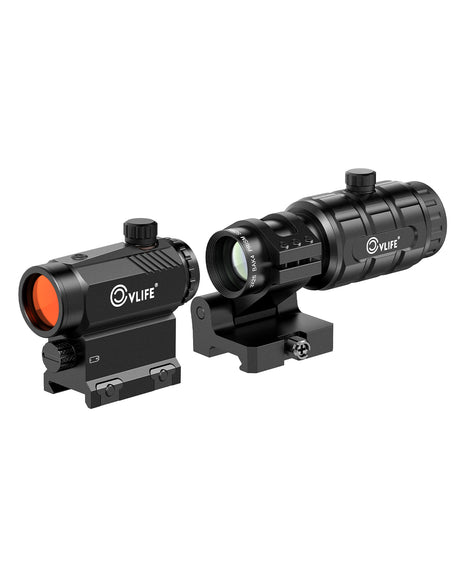Why Consider a Dual Optic Setup? 🤔
The concept of mounting both a red dot and LPVO on the same rifle might seem excessive at first, but this configuration addresses the inherent limitations of each individual optic system. While LPVOs offer excellent versatility across various distances, even the best 1x setting can't quite match the sheer speed of a dedicated red dot for close-quarters engagements. Conversely, red dots provide lightning-fast target acquisition but lack the magnification needed for precise shots at distance.
💡 Key Insight: The dual optic setup isn't about redundancy—it's about creating a system where each component excels in its area of specialization. You get the unparalleled speed of a red dot for immediate threats combined with the precision capability of an LPVO for engagements at distance.
Advantages ✅
- Unmatched versatility: Seamlessly transition between close-quarters speed and medium-range precision
- Optimal performance in respective roles: Each optic performs at its best without compromise
- Backup capability: If one optic fails, you have an immediate alternative
- Faster than magnification adjustment: No need to dial magnification—just shift your head position
- Ideal for dynamic shooting scenarios: Perfect for competitions or situations with unpredictable engagement distances
Considerations ⚠️
- Added weight: Two optics plus mounts increases overall rifle weight
- Cost investment: Requires purchasing two quality optics systems
- Potential cheek weld issues: May require adjustment to your shooting position
- Rail space consumption: Requires careful planning of accessory placement
- Training adaptation: Requires practice to efficiently transition between optics
Mounting Configurations for Dual Optics 🛠️
Successfully implementing a dual optic system requires careful consideration of mounting options. The configuration you choose will impact your shooting efficiency, comfort, and the overall balance of your rifle.
📌 Pro Tip: When using an offset mount, position it so the red dot is on the same side as your support hand. This allows you to activate the red dot by simply canting the rifle toward your support side, maintaining solid control of the firearm throughout the transition.
Step-by-Step Installation Guide 📋
Proper installation is critical for a functional dual optic system. Follow these steps to ensure optimal performance and reliability.
Begin by installing your LPVO in the standard position on the upper receiver. Ensure it's positioned for optimal eye relief with a natural cheek weld. Use a quality cantilever mount like the one included with CVLIFE LPVO scopes to achieve proper eye relief on your AR-15 platform.
Choose between offset or top mounting based on your preference. For offset mounting, attach the mount to your rail section immediately in front of the LPVO. For top mounting, ensure your LPVO mount has a matched rail section on top.
Mount your red dot to the chosen position. For offset mounts, ensure the red dot is positioned at a comfortable 35-45 degree angle. Use thread locker on mounting screws and torque to manufacturer specifications.
Zero your LPVO first at your preferred distance (typically 100 yards). Then zero your red dot at a practical distance for close-quarters engagements (25-50 yards). Document your zero settings for future reference.
Practice transitioning between optics and make any necessary adjustments to mounting positions. Ensure you can quickly and consistently acquire sight pictures through both optics from your natural shooting positions.
Optics Comparison: Understanding Your Options
When selecting optics for your dual setup, understanding the strengths and limitations of each type helps create a more effective system.
| Feature | Red Dot Sight | LPVO Scope | Combined System |
|---|---|---|---|
| Close-Quarters Speed | Excellent ⚡⚡⚡⚡⚡ | Very Good (at 1x) ⚡⚡⚡ | Excellent ⚡⚡⚡⚡⚡ |
| Medium-Range Precision | Limited | Excellent 🎯🎯🎯🎯🎯 | Excellent 🎯🎯🎯🎯🎯 |
| Transition Speed | N/A | N/A | Very Fast (with practice) 🔄 |
| Weight | Light | Moderate | Heavier |
| Versatility | Limited | High | Maximum 🔄🎯⚡ |
| Learning Curve | Minimal | Moderate | Significant (transitions) |
Training with Your Dual Optic System 🎯
Simply mounting both optics isn't enough—you need to develop proficiency in transitioning between them efficiently. Incorporate these drills into your training regimen:
Transition Drills
- Button Drill: Set up targets at 10 and 100 yards. Engage close target with red dot, then immediately transition to LPVO for distant target.
- Unknown Distance Drill: Have a training partner position targets at random distances. Practice quickly assessing which optic to use.
- Failure Drill: Practice transitioning to your red dot after simulating LPVO failure (turning off illumination or covering lens).
- Positional Transition: Practice moving between shooting positions while transitioning between optics.
📌 Pro Tip: When practicing transitions, focus on maintaining proper fundamentals throughout the movement. Your grip, stance, and trigger finger discipline should remain consistent whether using the LPVO or red dot. Smooth, efficient transitions will come with repetition.
Recommended CVLIFE LPVO Options
When building a dual optic system, selecting the right LPVO is crucial. CVLIFE offers excellent options that provide the performance needed without breaking the bank.
CVLIFE EagleTalon 1-6x24 LPVO Scope with Cantilever Mount

This versatile optic is perfectly suited for dual optic configurations. The 1-6x magnification range handles both close and medium ranges effectively, while the included cantilever mount provides the ideal eye relief for AR-15 platforms. The bright illuminated reticle offers quick acquisition at 1x, while the 6x magnification provides plenty of precision for distance shooting.
View Product DetailsCVLIFE BearPower 1-10x24 LPVO Rifle Scope with Cantilever Mount

For those wanting even more magnification capability in their dual optic setup, the BearPower 1-10x24 offers an expanded range that bridges the gap between traditional LPVOs and higher magnification scopes. This optic maintains excellent 1x performance for close-quarters while providing true mid-range precision at higher magnifications. The generous eye box and clear glass make target acquisition smooth and natural.
Explore This OptionFrequently Asked Questions (FAQ) ❓
Both positions have their merits, and the "better" option often comes down to personal preference and shooting style. Offset mounts typically allow for a more consistent cheek weld with the LPVO and can be slightly faster for shooters who practice the canting motion. Top mounts offer a more natural vertical head movement that some find more intuitive. The best approach is to try both if possible and see which feels more natural for your shooting style.
The weight increase is noticeable but manageable for most shooters. A quality red dot adds 3-5 ounces, while an LPVO typically adds 16-24 ounces. Combined with mounts, you're looking at approximately 2-2.5 pounds of added weight forward of the receiver. While this affects balance and can increase fatigue during extended carry, most shooters find the trade-off acceptable for the capabilities gained. Using lighter mounting solutions and balancing the rifle with other components can help mitigate the weight impact.
Zero your LPVO first at your preferred distance—typically 100 yards for a general-purpose rifle. Then zero your red dot at a practical distance for its intended use, usually 25-50 yards. It's important to understand that your red dot will have a different point of impact at various distances due to height over bore considerations, so practice at multiple distances to learn your holds. Some shooters prefer to zero both optics at the same distance (typically 50 yards) to simplify mental calculations.
For most hunting scenarios, a dual optic setup may be excessive. However, in specific situations like hunting in mixed terrain (dense woods opening to fields) or for predators that might be encountered at various distances, the dual setup can be advantageous. The added weight might be a consideration for spot-and-stalk hunting where every ounce matters. For most big game hunting, a quality LPVO alone is sufficient, but the dual setup shines in dynamic environments where engagement distances change rapidly.
The transition requires practice but becomes natural with repetition. Initially, you'll need to consciously think about which optic to use, but with training, the process becomes subconscious. Most shooters can develop proficient transitions with 5-10 hours of dedicated practice. The key is to practice in varied scenarios—different positions, moving between shots, and under time pressure. Dry fire practice at home is an excellent way to build the muscle memory without ammunition costs.
Final Recommendations
The dual optic setup represents the pinnacle of versatility for the modern AR-15 platform. By combining the strengths of both red dot and LPVO technologies, you create a system capable of handling any engagement distance with optimal performance.
Is a dual optic setup right for you? Consider this configuration if:
- You regularly engage targets at both close and medium distances
- You participate in dynamic shooting sports or competitions
- You want maximum versatility from your primary rifle
- You're willing to invest time in training transitions
- Weight is a secondary consideration to capability
For those who demand the utmost in versatility and performance from their AR-15, the dual optic configuration offers capabilities that neither system can match alone. With proper setup and training, this combination provides an unparalleled shooting experience across the entire engagement spectrum.
Ready to Build Your Dual Optic System? 🚀
Now that you understand the benefits and considerations of running both a red dot and LPVO on your AR-15, you're ready to create your own versatile optics platform. Remember that proper mounting, zeroing, and training are essential to maximizing the potential of this setup.













